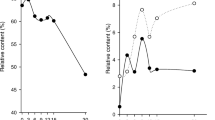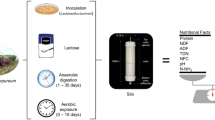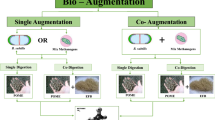Abstract
This paper analyses in a full-scale industrial process firstly the nitrogen compounds in all-malt and in maize-adjunct worts, then their fate during the main brewing steps and finally the influence on them of two different separation technologies: mash filter (Meura 2001) and lauter tun (Steinecker FVAS 26). Data showed that (1) maize-adjunct worts have a lower total nitrogen compounds than all-malt worts; (2) assimilable nitrogen represents 20–24% out of the total nitrogen in both all-malt and in adjunct worts; (3) free amino nitrogen nearly doubles in all-malt compared with adjunct worts; (4) proline and asparagine are the most abundant amino acids in both worts; (5) ammonium disappears during fermentation in wort with the lowest nitrogen content, i.e. in maize-adjunct wort. Moreover, the total nitrogen is reduced in all-malt by 80% with the Steinecker FVAS 26 lauter tun and 25% with the Meura 2001 filter, while in adjunct worts by 87% with the Steinecker FVAS 26 lauter tun and 29% with the Meura 2001 filter. After mash filtration, the content of assimilable nitrogen remains to be adequate for an efficient fermentation, but after lauter tun separation, the assimilable nitrogen reaches values that may compromise the regular fermentation process in both all-malt and adjunct worts. Therefore, when using lauter tun, we have to intervene to reduce its impact on nitrogen compounds and/or plan the wort nitrogen supplementation to overcome the stuck and sluggish fermentations.




Similar content being viewed by others
References
Bamforth CW (2001) Wort composition and beer quality. In: Smart K (ed) Brewing yeast fermentation performance. Blackwell, Oxford
Batistote M, Helena da Cruz S, Ernandes JS (2006) Altered patterns of maltose and glucose fermentation by brewing and wine yeasts influenced by complexity of nitrogen source. J Inst Brew 112:84–91
Bamforth CW (1985) The foaming properties of beer. J Inst Brew 91:370–383
Lekkas C, Stewart GG, Hill A, Taidi B, Hodgson J (2007) Elucidation of the role of nitrogenous wort components in yeast fermentation. J Inst Brew 113:3–8
O’Connor-Cox ESC, Ingledew WM (1989) Wort nitrogenous sources—their use by brewing yeasts: a review. J Am Soc Brew Chem 47:102–108
Pierce JS (1987) The role of nitrogen in brewing. J Inst Brew 93:378–381
Calderbank J, Rose A, Tubb RS (1985) Peptide removal from all malt and adjunct worts by Saccharomyces cerevisiae NCYC 240. J Inst Brew 91:321–324
Charalambous G (1981) Nitrogenous constituent of beer. In: Pollock JRA (ed) Brewing science vol no 2. Academic Press, New York, pp 196–214
Helena da Cruz S, Maffud Cilli E, Ernandes JR (2002) Structural complexity of the nitrogen source and influence on yeast growth and fermentation. J Inst Brew 108:54–61
Island MD, Naider F, Becker J (1987) Regulation of peptide transport in Saccharomyces cerevisiae by micromolar amino acid concentration. J Bacteriol 169:2132–2136
Kühbeck F, Back W, Krottenthaler M (2006) Influence of lauter turbidity on wort composition, fermentation performance and beer quality—a review. J Inst Brew 112:215–221
Manginot C, Roustan JL, Sablayrolles JM (1998) Nitrogen demand during alcoholic fermentation Importance of the stationary phase. Enzyme Microb Technol 23:511–517
Osman AM, Coverdale SM, Onley-Watson K, Bell D, Healy P (2003) The gel filtration Chromatographic-profiles of proteins and peptides of wort and beer: effect of processing-malting, mashing, kettle boiling, fermentation and filtering. J Inst Brew 109:41–51
Patterson CA, Ingledew WM (1999) Utilization of peptide by a lager brewing yeast. J Am Soc Brew Chem 57:1–8
Agu RC (2002) A comparison of maize, sorghum and barley as brewing adjuncts. J Inst Brew 108:19–22
Braekeleirs R, Vandenbussche J, Harmegnies F (2007) Practical experiences with mash filtration on thin-bed filter from brews made with several kinds of row materials. Tech Q Master Brew Assoc Am. 44:121–126
Agu RC, Palmer GH (1998) A reassessement of sorghum for lager-beer brewing. Bioresour Technol 66:253–261
Fumi MD, Galli R, Donadini G (2006) Brewing process and phenolic compounds in beer. In: Proceeding Convention 2006—The Institute of Brewing & Distilling—Asia Pacific Section—Hobart Tasmania, 19–24 March 2006
Glatthar J, Heinisch JJ, Senn T (2003) The use of unmalted triticale in brewing and its effect on wort and beer quality. J Am Soc Brew Chem 61:182–190
Lloyd WJW (1986) Centenary review—adjuncts. J Inst Brew 92:336–345
Taylor JRN, Boyd HK (1986) Free α-amino nitrogen production in sorghum beer mashing. J Sci Food Agric 37:1109–1117
Andrew J (2004) A review of progress in mash separation technology. Tech Q Master Brew Assoc Am 41:45–49
Harmegnies F, Marlé L, Tigel R (2006) Mash filtration: influence of sparging parameters on wort quality and sparging efficiency. Tech Q Master Brew Assoc Am 43:56–62
Italian Regulation L.16-8-1962 n. 1354. Disciplina igienica della produzione e del commercio della birra, G.U.R.I., 17 settembre 1962, n. 234, Roma, Italy
Analytica-EBC—Total nitrogen by Kjeldahl method. 2000, 8.9.1—Total free amino nitrogen. 2000, 8.10. Real Degree of Fermentation of Beer. 2000, 9.5
E.U. Regulation no. 2676/90. Metodi di analisi Comunitari da utilizzare nel settore del Vino. G.U.C.E., 1990, L272, 33
Colagrande O, Silva A, Casoli A (1984) Acides amines dans les vins mousseux. Conn Vigne Vin 15:27–48
Agu RC, Palmer GH (1999) Comparative development of soluble nitrogen in malts of barley and sorgum. Process Biochem 35:97–502
Pejin J, Grujic O, Markov S, Kocic-Tanackov S (2006) Application of GC/MS method using SPE Columns for quantitative determination of diacetyl and 2, 3-pentanedione during beer fermentation. J Am Soc Brew Chem 64:52–60
O’Rourke T (2002) The function of wort boiling. Brew Intern 2:17–19
Jones M, Rainbow C (1999) Simple methods of determining major nitrogenous compounds in wort and beer. Am Soc Brew Chem 57:9–17
Ingledew WM, Sosulski FW, Magnus CA (1986) An assessment of yeast foods and their utility in brewing and enology. J Am Soc Brew Chem 44:166–170
Iemura Y, Yamada T, Takashashi K, Furukawa K, Hara S (1999) Influence of amino acid content in seed mash on peptide uptake by yeast cells in main mash in sake brewing process. J Biosci Bioeng 88:679–681
Horák J (1997) Yeast nutrient transporters. Biochim Biophys Acta 1331:223–256
Ter Schure EK, Van Riel NAW, Verrips CT (2000) The role of ammonia metabolism in nitrogen catabolite repression in Saccharomyces cerevisiae. FEMS Microbiol Rev 24:67–83
Magasanik B (1992) Regulation of nitrogen utilization. In: Jones Pringles, Broads (eds) The molecular and cellular biology of the yeast Saccharomyces: gene expression. Cold Springer Harbor, New york, p 283
Author information
Authors and Affiliations
Corresponding author
Rights and permissions
About this article
Cite this article
Fumi, M.D., Galli, R., Lambri, M. et al. Impact of full-scale brewing processes on lager beer nitrogen compounds. Eur Food Res Technol 230, 209–216 (2009). https://doi.org/10.1007/s00217-009-1161-6
Received:
Revised:
Accepted:
Published:
Issue Date:
DOI: https://doi.org/10.1007/s00217-009-1161-6




